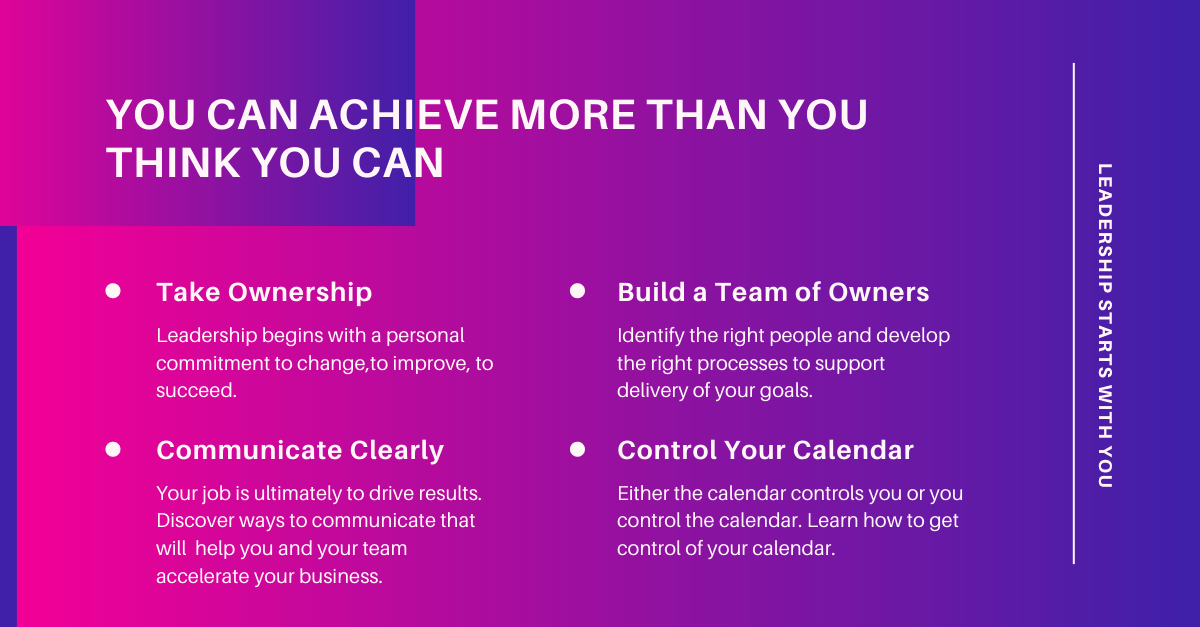Leadership begins with a personal commitment to change.
People can accomplish amazing things when they step outside their comfort zones and test their limits. But rarely do we take up the challenge of finding out what our true limits are.
Too often, we allow ourselves to be defined by other people, our current job, our education, our upbringing or our experience. Thus we tend to focus on inadequacies and settle for the status quo. We have worked with hundreds of corporate leaders who believed couldn’t escape from this rut. But our experience tells us that you can achieve much more than you think you can—if you commit to it.
Make the Commitment
Leadership, at any level of an organization, begins with a personal commitment to change, to improve, to succeed.
You must take responsibility for the end results of your efforts. Even when you think your challenges stem from others who are in your way, have made life difficult, are not carrying out their responsibilities or reaching their goals, it is still about you. It’s not about them.
Of course, it’s important to assess each situation from multiple perspectives, but it’s essential to start with yourself. Ask first what changes you can make, what actions you can take, to address the problem or opportunity.
You cannot control events and the actions of those around you. In the end, the only actions you can control are your own. Leaders don’t view this as a limitation; they recognize it as a source of power.
Cross the Bridge
Most people who rise to a leadership position want to lead. They aspire to make things happen, to have an impact on the world around them. In business, the opportunity to do this typically comes along through a series of individual successes driven by a specific skill or practice. When you land the promotion, you are asked to lead others.
Many of the leaders we meet find it challenging to “cross the bridge” to a higher level of leadership responsibility. Their immediate inclination is to apply to their new role the very same work habits, abilities, and attitudes that got them the promotion. Yet many of the attributes that made them successful in the last job can doom them to failure in the new one. Whether you’re a top salesperson promoted to sales manager or a COO promoted to CEO, you’ve got to recognize that new levels of responsibility often require fundamentally new approaches to leadership.
Business leaders often struggle to stop thinking of themselves as the “expert” and instead focus their energies on building around themselves a team of experts. As you rise up the chain of command, your job becomes less about doing things yourself and more about building in your organization the capacity to get those things done. Your job is primarily one of marshalling resources and developing people. You must embrace the notion that the members of your team—some of whom you will inherit and some of whom you will select—will contribute significantly to your success or failure.
That said, if your organization is not delivering the expected results, it’s you who is not delivering those results. As the leader, you must assume full responsibility. You must look inward to assess how you are enhancing the organization’s capacity to achieve the desired outcomes—and how you are getting in the way.
Remember, it starts with you. By making this commitment to personal responsibility, you will lead others to commit. And when each person in the organization displays this commitment, the organization can begin to make real progress toward business goals.
Try It
- Ask your team to list two or three critical areas in which your leadership is proving ineffective. What part of each situation can you control? What steps can you take to make the situation successful? How can you build on the areas where you’ve been effective?
- In one column, list the skills and habits that have allowed you to succeed in the past. In the next column, list the skills and habits that will likely determine your success going forward. In a third column, identify which skills and habits have impeded your success in the past. Use the information in the three columns to help you develop an action plan.









